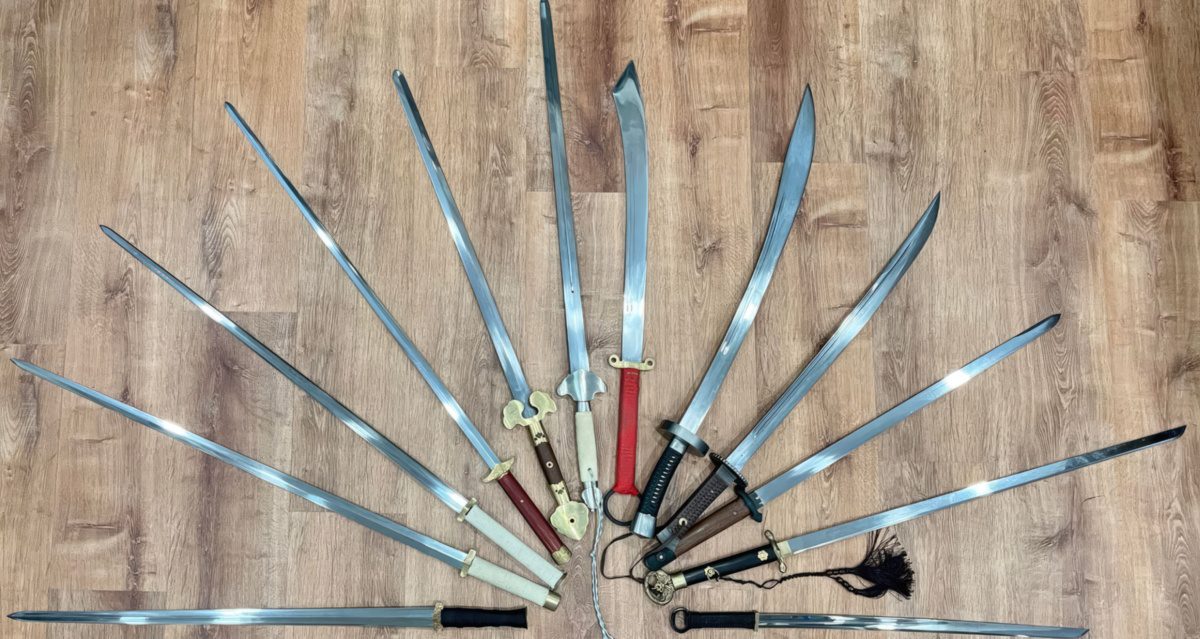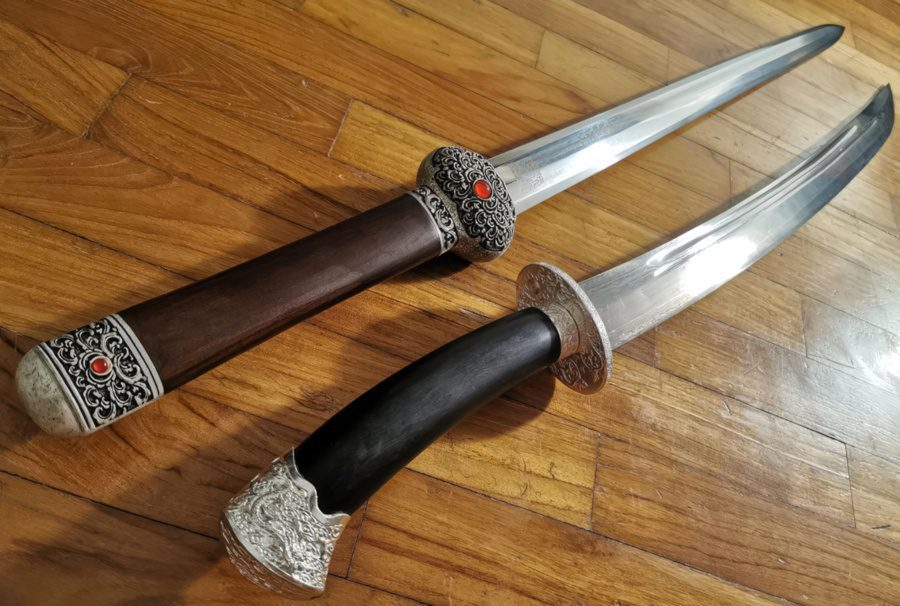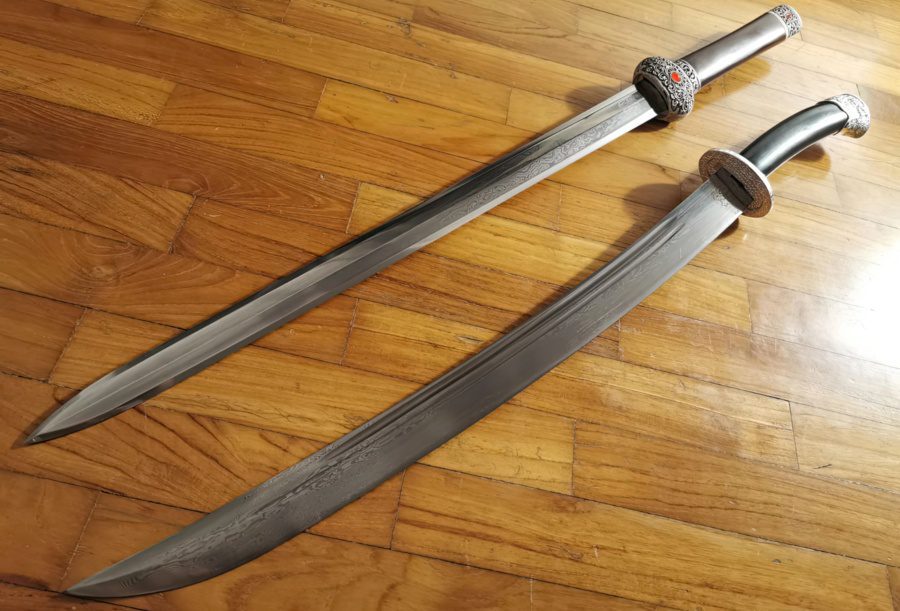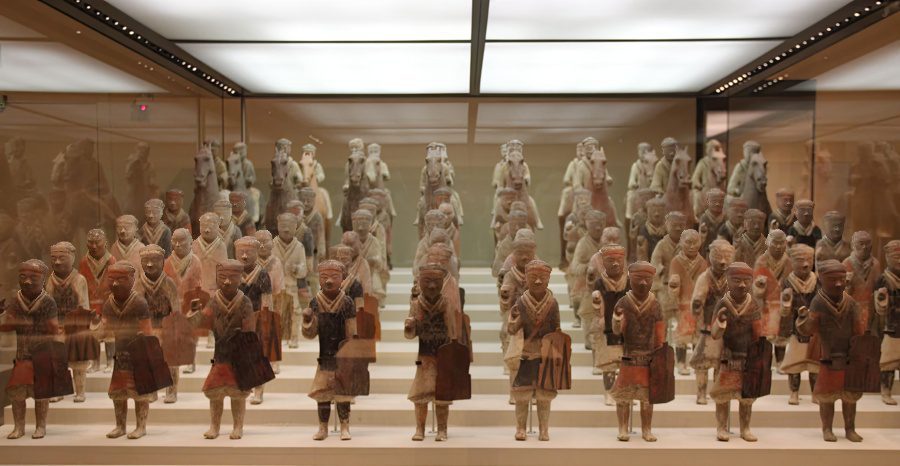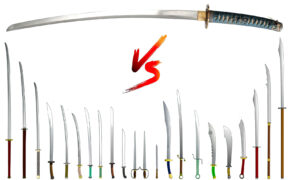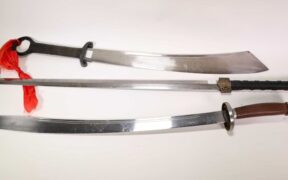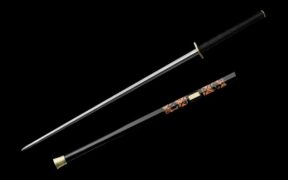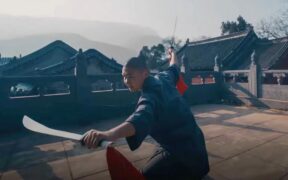u003colu003ern tu003cliu003eu003cspan data-sheets-root=u00221u0022 data-sheets-value=u0022{u0026quot;1u0026quot;:2,u0026quot;2u0026quot;:u0026quot;1. Bennett, N. (2018, December 1). "Chinese Arms and Armour". Books.
2. Rodell, S. M. (2005, September 1). "Chinese Swordsmanship – the Yang Family Taiji Jian Tradition".
3. Pegg, R., Yang, T., u0026amp; Figler, R. (2015, August 27). "Chinese Swords: An Ancient Tradition and Modern Training".
4. Sprague, M. (2013, June 25). "Chinese Swords: The Evolution and Use of the Jian and Dao".
5. Yang, J. M. (1999, March 9). "Ancient Chinese Weapons: A Martial Arts Guide".
6. Zhang, Y. (2009, June 23). "The Complete Taiji Dao: The Art of the Chinese Saber". Blue Snake
7. "Chinese Swords: Chinese Swords, Seven-Branched Sword, Jian, Dao, Guan Dao, Hook Sword, Sword of Goujian, Taijijian, Butterfly Sword, Zhanmadao". (2010, May 1)
8. Burton, R. F. (2014, April 1). "The Book of the Sword: A History of Daggers, Sabers, and Scimitars from Ancient Times to the Modern Day".
9. Wilkinson, E. P. (1991, January 1). "The History of Imperial China: A Research Guide: Vol. No. 49".u0026quot;}u0022 data-sheets-userformat=u0022{u0026quot;2u0026quot;:513,u0026quot;3u0026quot;:{u0026quot;1u0026quot;:0},u0026quot;12u0026quot;:0}u0022u003eBennett, N. (2018, December 1). u0022u003ca href=u0022https://books.google.com/books?id=gsAzswEACAAJu0026amp;dq=Chinese+Arms+and+Armouru0026amp;hl=enu0026amp;newbks=1u0026amp;newbks_redir=1u0026amp;sa=Xu0026amp;ved=2ahUKEwjphbDF7aiFAxV6cGwGHZwlCw8Q6AF6BAgEEAIu0022u003eChinese Arms and Armouru003c/au003eu0022. Books.u003c/spanu003eu003c/liu003ern tu003cliu003eu003cspan data-sheets-root=u00221u0022 data-sheets-value=u0022{u0026quot;1u0026quot;:2,u0026quot;2u0026quot;:u0026quot;1. Bennett, N. (2018, December 1). "Chinese Arms and Armour". Books.
2. Rodell, S. M. (2005, September 1). "Chinese Swordsmanship – the Yang Family Taiji Jian Tradition".
3. Pegg, R., Yang, T., u0026amp; Figler, R. (2015, August 27). "Chinese Swords: An Ancient Tradition and Modern Training".
4. Sprague, M. (2013, June 25). "Chinese Swords: The Evolution and Use of the Jian and Dao".
5. Yang, J. M. (1999, March 9). "Ancient Chinese Weapons: A Martial Arts Guide".
6. Zhang, Y. (2009, June 23). "The Complete Taiji Dao: The Art of the Chinese Saber". Blue Snake
7. "Chinese Swords: Chinese Swords, Seven-Branched Sword, Jian, Dao, Guan Dao, Hook Sword, Sword of Goujian, Taijijian, Butterfly Sword, Zhanmadao". (2010, May 1)
8. Burton, R. F. (2014, April 1). "The Book of the Sword: A History of Daggers, Sabers, and Scimitars from Ancient Times to the Modern Day".
9. Wilkinson, E. P. (1991, January 1). "The History of Imperial China: A Research Guide: Vol. No. 49".u0026quot;}u0022 data-sheets-userformat=u0022{u0026quot;2u0026quot;:513,u0026quot;3u0026quot;:{u0026quot;1u0026quot;:0},u0026quot;12u0026quot;:0}u0022u003eRodell, S. M. (2005, September 1). u0022u003ca href=u0022https://books.google.com.ph/books?id=8rObpwAACAAJu0026amp;dq=Chinese+Swordsmanship+%E2%80%93+the+Yang+Family+Taiji+Jian+Traditionu0026amp;hl=enu0026amp;newbks=1u0026amp;newbks_redir=1u0026amp;sa=Xu0026amp;ved=2ahUKEwiY0ZHM7aiFAxV4RmwGHcYmD24Q6AF6BAgQEAEu0022u003eChinese Swordsmanship – the Yang Family Taiji Jian Traditionu003c/au003eu0022.u003c/spanu003eu003c/liu003ern tu003cliu003eu003cspan data-sheets-root=u00221u0022 data-sheets-value=u0022{u0026quot;1u0026quot;:2,u0026quot;2u0026quot;:u0026quot;1. Bennett, N. (2018, December 1). "Chinese Arms and Armour". Books.
2. Rodell, S. M. (2005, September 1). "Chinese Swordsmanship – the Yang Family Taiji Jian Tradition".
3. Pegg, R., Yang, T., u0026amp; Figler, R. (2015, August 27). "Chinese Swords: An Ancient Tradition and Modern Training".
4. Sprague, M. (2013, June 25). "Chinese Swords: The Evolution and Use of the Jian and Dao".
5. Yang, J. M. (1999, March 9). "Ancient Chinese Weapons: A Martial Arts Guide".
6. Zhang, Y. (2009, June 23). "The Complete Taiji Dao: The Art of the Chinese Saber". Blue Snake
7. "Chinese Swords: Chinese Swords, Seven-Branched Sword, Jian, Dao, Guan Dao, Hook Sword, Sword of Goujian, Taijijian, Butterfly Sword, Zhanmadao". (2010, May 1)
8. Burton, R. F. (2014, April 1). "The Book of the Sword: A History of Daggers, Sabers, and Scimitars from Ancient Times to the Modern Day".
9. Wilkinson, E. P. (1991, January 1). "The History of Imperial China: A Research Guide: Vol. No. 49".u0026quot;}u0022 data-sheets-userformat=u0022{u0026quot;2u0026quot;:513,u0026quot;3u0026quot;:{u0026quot;1u0026quot;:0},u0026quot;12u0026quot;:0}u0022u003ePegg, R., Yang, T., u0026amp; Figler, R. (2015, August 27). u0022u003ca href=u0022https://books.google.com.ph/books?id=3MU0jgEACAAJu0026amp;dq=Chinese+Swords:+An+Ancient+Tradition+and+Modern+Trainingu0026amp;hl=enu0026amp;newbks=1u0026amp;newbks_redir=1u0026amp;sa=Xu0026amp;ved=2ahUKEwi718zR7aiFAxXmXWwGHck5BuAQ6AF6BAgHEAIu0022u003eChinese Swords: An Ancient Tradition and Modern Trainingu003c/au003eu0022.u003c/spanu003eu003c/liu003ern tu003cliu003eu003cspan data-sheets-root=u00221u0022 data-sheets-value=u0022{u0026quot;1u0026quot;:2,u0026quot;2u0026quot;:u0026quot;1. Bennett, N. (2018, December 1). "Chinese Arms and Armour". Books.
2. Rodell, S. M. (2005, September 1). "Chinese Swordsmanship – the Yang Family Taiji Jian Tradition".
3. Pegg, R., Yang, T., u0026amp; Figler, R. (2015, August 27). "Chinese Swords: An Ancient Tradition and Modern Training".
4. Sprague, M. (2013, June 25). "Chinese Swords: The Evolution and Use of the Jian and Dao".
5. Yang, J. M. (1999, March 9). "Ancient Chinese Weapons: A Martial Arts Guide".
6. Zhang, Y. (2009, June 23). "The Complete Taiji Dao: The Art of the Chinese Saber". Blue Snake
7. "Chinese Swords: Chinese Swords, Seven-Branched Sword, Jian, Dao, Guan Dao, Hook Sword, Sword of Goujian, Taijijian, Butterfly Sword, Zhanmadao". (2010, May 1)
8. Burton, R. F. (2014, April 1). "The Book of the Sword: A History of Daggers, Sabers, and Scimitars from Ancient Times to the Modern Day".
9. Wilkinson, E. P. (1991, January 1). "The History of Imperial China: A Research Guide: Vol. No. 49".u0026quot;}u0022 data-sheets-userformat=u0022{u0026quot;2u0026quot;:513,u0026quot;3u0026quot;:{u0026quot;1u0026quot;:0},u0026quot;12u0026quot;:0}u0022u003eSprague, M. (2013, June 25). u0022u003ca href=u0022https://books.google.com/books?id=aTpbngEACAAJu0026amp;dq=Chinese+Swords:+The+Evolution+and+Use+of+the+Jian+and+Daou0026amp;hl=enu0026amp;newbks=1u0026amp;newbks_redir=1u0026amp;sa=Xu0026amp;ved=2ahUKEwjt-JPW7aiFAxVNXGwGHcXzC8wQ6AF6BAgGEAIu0022u003eChinese Swords: The Evolution and Use of the Jian and Daou003c/au003eu0022.u003c/spanu003eu003c/liu003ern tu003cliu003eu003cspan data-sheets-root=u00221u0022 data-sheets-value=u0022{u0026quot;1u0026quot;:2,u0026quot;2u0026quot;:u0026quot;1. Bennett, N. (2018, December 1). "Chinese Arms and Armour". Books.
2. Rodell, S. M. (2005, September 1). "Chinese Swordsmanship – the Yang Family Taiji Jian Tradition".
3. Pegg, R., Yang, T., u0026amp; Figler, R. (2015, August 27). "Chinese Swords: An Ancient Tradition and Modern Training".
4. Sprague, M. (2013, June 25). "Chinese Swords: The Evolution and Use of the Jian and Dao".
5. Yang, J. M. (1999, March 9). "Ancient Chinese Weapons: A Martial Arts Guide".
6. Zhang, Y. (2009, June 23). "The Complete Taiji Dao: The Art of the Chinese Saber". Blue Snake
7. "Chinese Swords: Chinese Swords, Seven-Branched Sword, Jian, Dao, Guan Dao, Hook Sword, Sword of Goujian, Taijijian, Butterfly Sword, Zhanmadao". (2010, May 1)
8. Burton, R. F. (2014, April 1). "The Book of the Sword: A History of Daggers, Sabers, and Scimitars from Ancient Times to the Modern Day".
9. Wilkinson, E. P. (1991, January 1). "The History of Imperial China: A Research Guide: Vol. No. 49".u0026quot;}u0022 data-sheets-userformat=u0022{u0026quot;2u0026quot;:513,u0026quot;3u0026quot;:{u0026quot;1u0026quot;:0},u0026quot;12u0026quot;:0}u0022u003eYang, J. M. (1999, March 9). u0022u003ca href=u0022https://books.google.com.ph/books?id=U_XpnAAACAAJu0026amp;dq=Ancient+Chinese+Weapons:+A+Martial+Arts+Guideu0026amp;hl=enu0026amp;newbks=1u0026amp;newbks_redir=1u0026amp;sa=Xu0026amp;ved=2ahUKEwj0iNva7aiFAxV6e2wGHRYMAEoQ6AF6BAgCEAIu0022u003eAncient Chinese Weapons: A Martial Arts Guideu003c/au003eu0022.u003c/spanu003eu003c/liu003ern tu003cliu003eu003cspan data-sheets-root=u00221u0022 data-sheets-value=u0022{u0026quot;1u0026quot;:2,u0026quot;2u0026quot;:u0026quot;1. Bennett, N. (2018, December 1). "Chinese Arms and Armour". Books.
2. Rodell, S. M. (2005, September 1). "Chinese Swordsmanship – the Yang Family Taiji Jian Tradition".
3. Pegg, R., Yang, T., u0026amp; Figler, R. (2015, August 27). "Chinese Swords: An Ancient Tradition and Modern Training".
4. Sprague, M. (2013, June 25). "Chinese Swords: The Evolution and Use of the Jian and Dao".
5. Yang, J. M. (1999, March 9). "Ancient Chinese Weapons: A Martial Arts Guide".
6. Zhang, Y. (2009, June 23). "The Complete Taiji Dao: The Art of the Chinese Saber". Blue Snake
7. "Chinese Swords: Chinese Swords, Seven-Branched Sword, Jian, Dao, Guan Dao, Hook Sword, Sword of Goujian, Taijijian, Butterfly Sword, Zhanmadao". (2010, May 1)
8. Burton, R. F. (2014, April 1). "The Book of the Sword: A History of Daggers, Sabers, and Scimitars from Ancient Times to the Modern Day".
9. Wilkinson, E. P. (1991, January 1). "The History of Imperial China: A Research Guide: Vol. No. 49".u0026quot;}u0022 data-sheets-userformat=u0022{u0026quot;2u0026quot;:513,u0026quot;3u0026quot;:{u0026quot;1u0026quot;:0},u0026quot;12u0026quot;:0}u0022u003eZhang, Y. (2009, June 23). u0022u003ca href=u0022https://books.google.com.ph/books?id=eQjLjqo774QCu0026amp;printsec=frontcoveru0026amp;dq=The+Complete+Taiji+Dao:+The+Art+of+the+Chinese+Saberu0026amp;hl=enu0026amp;newbks=1u0026amp;newbks_redir=1u0026amp;sa=Xu0026amp;ved=2ahUKEwiZpenf7aiFAxVTfGwGHe8dB-EQ6AF6BAgKEAIu0022u003eThe Complete Taiji Dao: The Art of the Chinese Saberu003c/au003eu0022. Blue Snakeu003c/spanu003eu003c/liu003ern tu003cliu003eu003cspan data-sheets-root=u00221u0022 data-sheets-value=u0022{u0026quot;1u0026quot;:2,u0026quot;2u0026quot;:u0026quot;1. Bennett, N. (2018, December 1). "Chinese Arms and Armour". Books.
2. Rodell, S. M. (2005, September 1). "Chinese Swordsmanship – the Yang Family Taiji Jian Tradition".
3. Pegg, R., Yang, T., u0026amp; Figler, R. (2015, August 27). "Chinese Swords: An Ancient Tradition and Modern Training".
4. Sprague, M. (2013, June 25). "Chinese Swords: The Evolution and Use of the Jian and Dao".
5. Yang, J. M. (1999, March 9). "Ancient Chinese Weapons: A Martial Arts Guide".
6. Zhang, Y. (2009, June 23). "The Complete Taiji Dao: The Art of the Chinese Saber". Blue Snake
7. "Chinese Swords: Chinese Swords, Seven-Branched Sword, Jian, Dao, Guan Dao, Hook Sword, Sword of Goujian, Taijijian, Butterfly Sword, Zhanmadao". (2010, May 1)
8. Burton, R. F. (2014, April 1). "The Book of the Sword: A History of Daggers, Sabers, and Scimitars from Ancient Times to the Modern Day".
9. Wilkinson, E. P. (1991, January 1). "The History of Imperial China: A Research Guide: Vol. No. 49".u0026quot;}u0022 data-sheets-userformat=u0022{u0026quot;2u0026quot;:513,u0026quot;3u0026quot;:{u0026quot;1u0026quot;:0},u0026quot;12u0026quot;:0}u0022u003eu0022Chinese Swords: Chinese Swords, Seven-Branched Sword, Jian, Dao, Guan Dao, Hook Sword, Sword of Goujian, Taijijian, Butterfly Sword, Zhanmadaou0022. (2010, May 1)u003c/spanu003eu003c/liu003ern tu003cliu003eu003cspan data-sheets-root=u00221u0022 data-sheets-value=u0022{u0026quot;1u0026quot;:2,u0026quot;2u0026quot;:u0026quot;1. Bennett, N. (2018, December 1). "Chinese Arms and Armour". Books.
2. Rodell, S. M. (2005, September 1). "Chinese Swordsmanship – the Yang Family Taiji Jian Tradition".
3. Pegg, R., Yang, T., u0026amp; Figler, R. (2015, August 27). "Chinese Swords: An Ancient Tradition and Modern Training".
4. Sprague, M. (2013, June 25). "Chinese Swords: The Evolution and Use of the Jian and Dao".
5. Yang, J. M. (1999, March 9). "Ancient Chinese Weapons: A Martial Arts Guide".
6. Zhang, Y. (2009, June 23). "The Complete Taiji Dao: The Art of the Chinese Saber". Blue Snake
7. "Chinese Swords: Chinese Swords, Seven-Branched Sword, Jian, Dao, Guan Dao, Hook Sword, Sword of Goujian, Taijijian, Butterfly Sword, Zhanmadao". (2010, May 1)
8. Burton, R. F. (2014, April 1). "The Book of the Sword: A History of Daggers, Sabers, and Scimitars from Ancient Times to the Modern Day".
9. Wilkinson, E. P. (1991, January 1). "The History of Imperial China: A Research Guide: Vol. No. 49".u0026quot;}u0022 data-sheets-userformat=u0022{u0026quot;2u0026quot;:513,u0026quot;3u0026quot;:{u0026quot;1u0026quot;:0},u0026quot;12u0026quot;:0}u0022u003eBurton, R. F. (2014, April 1). u0022u003ca href=u0022https://books.google.com/books?id=NFyCDwAAQBAJu0026amp;printsec=frontcoveru0026amp;dq=The+Book+of+the+Sword:+A+History+of+Daggers,+Sabers,+and+Scimitars+from+Ancient+Times+to+the+Modern+Dayu0026amp;hl=enu0026amp;newbks=1u0026amp;newbks_redir=1u0026amp;sa=Xu0026amp;ved=2ahUKEwiRs_7p7aiFAxVTfGwGHe8dB-EQ6AF6BAgNEAIu0022u003eThe Book of the Sword: A History of Daggers, Sabers, and Scimitars from Ancient Times to the Modern Dayu003c/au003eu0022.u003c/spanu003eu003c/liu003ern tu003cliu003eu003cspan data-sheets-root=u00221u0022 data-sheets-value=u0022{u0026quot;1u0026quot;:2,u0026quot;2u0026quot;:u0026quot;1. Bennett, N. (2018, December 1). "Chinese Arms and Armour". Books.
2. Rodell, S. M. (2005, September 1). "Chinese Swordsmanship – the Yang Family Taiji Jian Tradition".
3. Pegg, R., Yang, T., u0026amp; Figler, R. (2015, August 27). "Chinese Swords: An Ancient Tradition and Modern Training".
4. Sprague, M. (2013, June 25). "Chinese Swords: The Evolution and Use of the Jian and Dao".
5. Yang, J. M. (1999, March 9). "Ancient Chinese Weapons: A Martial Arts Guide".
6. Zhang, Y. (2009, June 23). "The Complete Taiji Dao: The Art of the Chinese Saber". Blue Snake
7. "Chinese Swords: Chinese Swords, Seven-Branched Sword, Jian, Dao, Guan Dao, Hook Sword, Sword of Goujian, Taijijian, Butterfly Sword, Zhanmadao". (2010, May 1)
8. Burton, R. F. (2014, April 1). "The Book of the Sword: A History of Daggers, Sabers, and Scimitars from Ancient Times to the Modern Day".
9. Wilkinson, E. P. (1991, January 1). "The History of Imperial China: A Research Guide: Vol. No. 49".u0026quot;}u0022 data-sheets-userformat=u0022{u0026quot;2u0026quot;:513,u0026quot;3u0026quot;:{u0026quot;1u0026quot;:0},u0026quot;12u0026quot;:0}u0022u003eWilkinson, E. P. (1991, January 1). u0022u003ca href=u0022https://books.google.com/books?id=VzaeAQAACAAJu0026amp;dq=The+History+of+Imperial+China:+A+Research+Guide:+Vol.+No.+49u0026amp;hl=enu0026amp;newbks=1u0026amp;newbks_redir=1u0026amp;sa=Xu0026amp;ved=2ahUKEwid98Hv7aiFAxUPUGwGHZggAxsQ6AF6BAgHEAEu0022u003eThe History of Imperial China: A Research Guide: Vol. No. 49u003c/au003eu0022.u003c/spanu003eu003c/liu003ernu003c/olu003e
